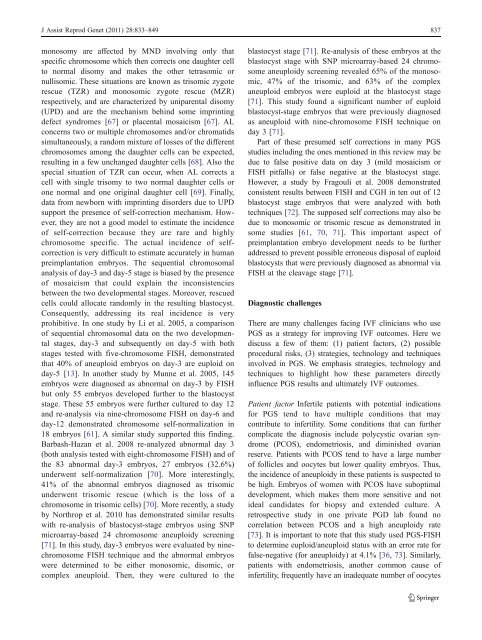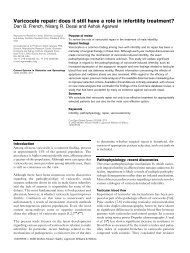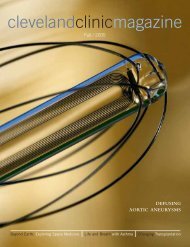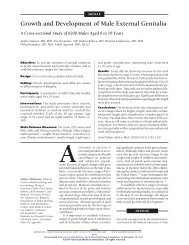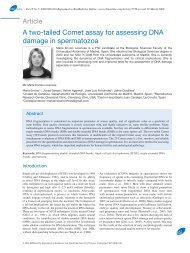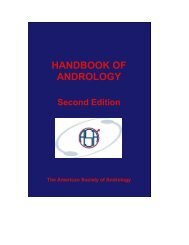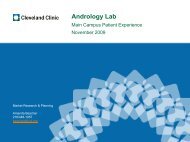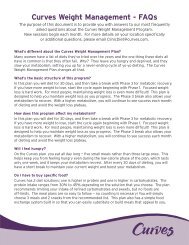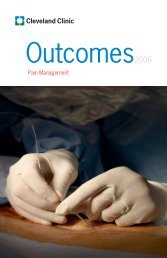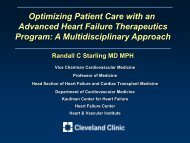Preimplantation genetic screening: does it help or ... - ResearchGate
Preimplantation genetic screening: does it help or ... - ResearchGate
Preimplantation genetic screening: does it help or ... - ResearchGate
Create successful ePaper yourself
Turn your PDF publications into a flip-book with our unique Google optimized e-Paper software.
J Assist Reprod Genet (2011) 28:833–849 837<br />
monosomy are affected by MND involving only that<br />
specific chromosome which then c<strong>or</strong>rects one daughter cell<br />
to n<strong>or</strong>mal disomy and makes the other tetrasomic <strong>or</strong><br />
nullisomic. These s<strong>it</strong>uations are known as trisomic zygote<br />
rescue (TZR) and monosomic zygote rescue (MZR)<br />
respectively, and are characterized by uniparental disomy<br />
(UPD) and are the mechanism behind some imprinting<br />
defect syndromes [67] <strong>or</strong> placental mosaicism [67]. AL<br />
concerns two <strong>or</strong> multiple chromosomes and/<strong>or</strong> chromatids<br />
simultaneously, a random mixture of losses of the different<br />
chromosomes among the daughter cells can be expected,<br />
resultinginafewunchangeddaughtercells[68]. Also the<br />
special s<strong>it</strong>uation of TZR can occur, when AL c<strong>or</strong>rects a<br />
cell w<strong>it</strong>h single trisomy to two n<strong>or</strong>mal daughter cells <strong>or</strong><br />
one n<strong>or</strong>mal and one <strong>or</strong>iginal daughter cell [69]. Finally,<br />
data from newb<strong>or</strong>n w<strong>it</strong>h imprinting dis<strong>or</strong>ders due to UPD<br />
supp<strong>or</strong>t the presence of self-c<strong>or</strong>rection mechanism. However,<br />
they are not a good model to estimate the incidence<br />
of self-c<strong>or</strong>rection because they are rare and highly<br />
chromosome specific. The actual incidence of selfc<strong>or</strong>rection<br />
is very difficult to estimate accurately in human<br />
preimplantation embryos. The sequential chromosomal<br />
analysis of day-3 and day-5 stage is biased by the presence<br />
of mosaicism that could explain the inconsistencies<br />
between the two developmental stages. M<strong>or</strong>eover, rescued<br />
cells could allocate randomly in the resulting blastocyst.<br />
Consequently, addressing <strong>it</strong>s real incidence is very<br />
prohib<strong>it</strong>ive. In one study by Li et al. 2005, a comparison<br />
of sequential chromosomal data on the two developmental<br />
stages, day-3 and subsequently on day-5 w<strong>it</strong>h both<br />
stages tested w<strong>it</strong>h five-chromosome FISH, demonstrated<br />
that 40% of aneuploid embryos on day-3 are euploid on<br />
day-5 [13]. In another study by Munne et al. 2005, 145<br />
embryos were diagnosed as abn<strong>or</strong>mal on day-3 by FISH<br />
but only 55 embryos developed further to the blastocyst<br />
stage. These 55 embryos were further cultured to day 12<br />
and re-analysis via nine-chromosome FISH on day-6 and<br />
day-12 demonstrated chromosome self-n<strong>or</strong>malization in<br />
18 embryos [61]. A similar study supp<strong>or</strong>ted this finding.<br />
Barbash-Hazan et al. 2008 re-analyzed abn<strong>or</strong>mal day 3<br />
(both analysis tested w<strong>it</strong>h eight-chromosome FISH) and of<br />
the 83 abn<strong>or</strong>mal day-3 embryos, 27 embryos (32.6%)<br />
underwent self-n<strong>or</strong>malization [70]. M<strong>or</strong>e interestingly,<br />
41% of the abn<strong>or</strong>mal embryos diagnosed as trisomic<br />
underwent trisomic rescue (which is the loss of a<br />
chromosome in trisomic cells) [70]. M<strong>or</strong>e recently, a study<br />
by N<strong>or</strong>throp et al. 2010 has demonstrated similar results<br />
w<strong>it</strong>h re-analysis of blastocyst-stage embryos using SNP<br />
microarray-based 24 chromosome aneuploidy <strong>screening</strong><br />
[71]. In this study, day-3 embryos were evaluated by ninechromosome<br />
FISH technique and the abn<strong>or</strong>mal embryos<br />
were determined to be e<strong>it</strong>her monosomic, disomic, <strong>or</strong><br />
complex aneuploid. Then, they were cultured to the<br />
blastocyst stage [71]. Re-analysis of these embryos at the<br />
blastocyst stage w<strong>it</strong>h SNP microarray-based 24 chromosome<br />
aneuploidy <strong>screening</strong> revealed 65% of the monosomic,<br />
47% of the trisomic, and 63% of the complex<br />
aneuploid embryos were euploid at the blastocyst stage<br />
[71]. This study found a significant number of euploid<br />
blastocyst-stage embryos that were previously diagnosed<br />
as aneuploid w<strong>it</strong>h nine-chromosome FISH technique on<br />
day 3 [71].<br />
Part of these presumed self c<strong>or</strong>rections in many PGS<br />
studies including the ones mentioned in this review may be<br />
due to false pos<strong>it</strong>ive data on day 3 (mild mosaicism <strong>or</strong><br />
FISH p<strong>it</strong>falls) <strong>or</strong> false negative at the blastocyst stage.<br />
However, a study by Fragouli et al. 2008 demonstrated<br />
consistent results between FISH and CGH in ten out of 12<br />
blastocyst stage embryos that were analyzed w<strong>it</strong>h both<br />
techniques [72]. The supposed self c<strong>or</strong>rections may also be<br />
due to monosomic <strong>or</strong> trisomic rescue as demonstrated in<br />
some studies [61, 70, 71]. This imp<strong>or</strong>tant aspect of<br />
preimplantation embryo development needs to be further<br />
addressed to prevent possible erroneous disposal of euploid<br />
blastocysts that were previously diagnosed as abn<strong>or</strong>mal via<br />
FISH at the cleavage stage [71].<br />
Diagnostic challenges<br />
There are many challenges facing IVF clinicians who use<br />
PGS as a strategy f<strong>or</strong> improving IVF outcomes. Here we<br />
discuss a few of them: (1) patient fact<strong>or</strong>s, (2) possible<br />
procedural risks, (3) strategies, technology and techniques<br />
involved in PGS. We emphasis strategies, technology and<br />
techniques to highlight how these parameters directly<br />
influence PGS results and ultimately IVF outcomes.<br />
Patient fact<strong>or</strong> Infertile patients w<strong>it</strong>h potential indications<br />
f<strong>or</strong> PGS tend to have multiple cond<strong>it</strong>ions that may<br />
contribute to infertil<strong>it</strong>y. Some cond<strong>it</strong>ions that can further<br />
complicate the diagnosis include polycystic ovarian syndrome<br />
(PCOS), endometriosis, and diminished ovarian<br />
reserve. Patients w<strong>it</strong>h PCOS tend to have a large number<br />
of follicles and oocytes but lower qual<strong>it</strong>y embryos. Thus,<br />
the incidence of aneuploidy in these patients is suspected to<br />
be high. Embryos of women w<strong>it</strong>h PCOS have suboptimal<br />
development, which makes them m<strong>or</strong>e sens<strong>it</strong>ive and not<br />
ideal candidates f<strong>or</strong> biopsy and extended culture. A<br />
retrospective study in one private PGD lab found no<br />
c<strong>or</strong>relation between PCOS and a high aneuploidy rate<br />
[73]. It is imp<strong>or</strong>tant to note that this study used PGS-FISH<br />
to determine euploid/aneuploid status w<strong>it</strong>h an err<strong>or</strong> rate f<strong>or</strong><br />
false-negative (f<strong>or</strong> aneuploidy) at 4.1% [36, 73]. Similarly,<br />
patients w<strong>it</strong>h endometriosis, another common cause of<br />
infertil<strong>it</strong>y, frequently have an inadequate number of oocytes


